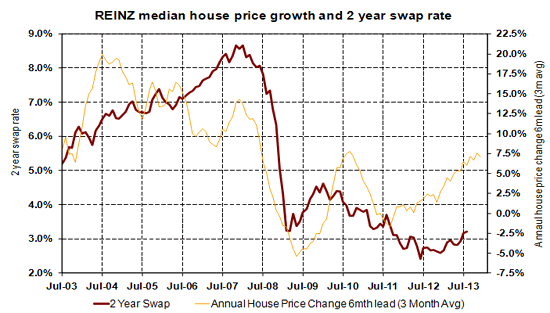
 By Roger J Kerr
By Roger J Kerr
The future GDP growth, inflation and thus monetary settings / interest rate equation should be reasonably straight forward for the RBNZ to work out.
If forecast inflation is heading above 2.00% towards 3.00% then monetary conditions have to be set on the tighter side of neutral 12 to 18 month ahead of the anticipated inflation rise.
However, it seems there the picture is being unnecessarily clouded by the implementation of macro-prudential regulations which are more about bank financial stability in a boom/bust residential property cycle.
To be fair, I have always regarded the threat of macro-prudential regulations on the banks as buying Governor Wheeler some time as he does not want to shove interest rates up too far ahead of US interest rates increasing and thus risk the Kiwi dollar skyrocketing again and killing off the export sector.
The impact of LVR limits or sectoral capital weights on the banks may slow up credit growth on the margin; however they are not a substitute for prudent monetary policy management through increasing the OCR.
The RBNZ’s OCR review this week is not expected to shed any new light on when and how they will commence the job of increasing the OCR from the earthquake-induced low setting of 2.5% in 2011.
While Governor Wheeler will be reasonably non-committal at this time, he will be aware that the pressure is mounting on the RBNZ to extricate themselves from the 2.5% OCR “emergency levels” put in place at the height of the GFC in March 2009.
The longer he leaves it, the more difficult the adjustment becomes.
The two-year wholesale swap rate is always the barometer on how the interest rate markets are pricing the timing and speed of future OCR increases.
As can be seen from the chart below the moneymarkets are ignoring the lower than expected historical GDP and CPI figures released recently and are pricing higher at 3.25% for several good reasons:-
· Elevated consumer/business confidence levels pointing to annual GDP growth above 3.00%.
· A TWI currency index well below RBNZ inflation forecast assumptions, thus tradable inflation tracking higher over the next 12 months. Non-tradable inflation remains high (think insurance premiums!).
· House price increases continuing, fuelled by the demand/supply imbalance and now increasing net migration inflows.
· A potential $7 milksolids payout to dairy farmers this season having a positive ripple effect through the whole economy.
· The swaps market anticipating growing one-sided “fixed rate paying” demand from banks off-laying their risk from a larger number of borrowing customers fixing their mortgage interest rates.
Looking ahead, it is difficult to see what could cause the two-year swap rate to reverse back down or even stay static at 3.25%.

-----------------------------------------------------------
To subscribe to our daily Currency Rate Sheet email, enter your email address here.
No chart with that title exists.
Roger J Kerr is a partner at PwC. He specialises in fixed interest securities and is a commentator on economics and markets. More commentary and useful information on fixed interest investing can be found at rogeradvice.com
4 Comments
I think Kerr is a very smart chap and generally what he says is pretty good advice!
Institutional investors still demanding that NZ provides easy low risk high interest returns. We already offer a full 200 points above all other developed countries.
Whose pawn are we?
The RBNZ’s OCR review this week is not expected to shed any new light on when and how they will commence the job of increasing the OCR from the earthquake-induced low setting of 2.5% in 2011.
While Governor Wheeler will be reasonably non-committal at this time, he will be aware that the pressure is mounting on the RBNZ to extricate themselves from the 2.5% OCR “emergency levels” put in place at the height of the GFC in March 2009.
Surely RBNZ policy locking OCR down @ 2.5% paved the way to paper prosperity? Does Wheeler have the authority to dislocate the illusion of recovery?
There are far to many unknowns in this paper mashie world we now live in to be ratcheting up interest rates. With China slowing and the doubt over the US's ability to function with out some form of Q.E. Add to this the state of many European economies and it is not a good time to be putting the clamps on. A little risk of some inflation is bearable when looking at the alternative.

We welcome your comments below. If you are not already registered, please register to comment
Remember we welcome robust, respectful and insightful debate. We don't welcome abusive or defamatory comments and will de-register those repeatedly making such comments. Our current comment policy is here.